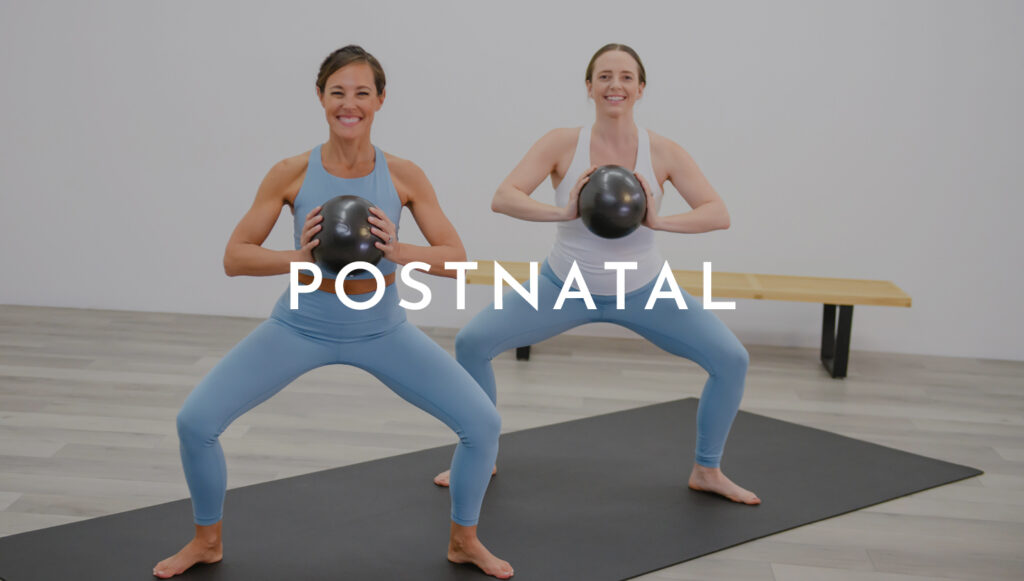
You might be surprised to discover that you retain your baby belly for weeks, even months, after giving birth. But if I might point out — your body has just housed a human being who demanded luxurious living quarters for nine months, and now your muscles and skin must adjust to the baby’s absence.
C-section recovery time requires a touch more care than a vaginal delivery, but ultimately, it does not mean catastrophe — not in the least! The Moms Into Fitness Postnatal Exercise Program will help you safely exercise again. But before you dive in, there are some important things you must take into consideration …
Your body and emotions go through many, many changes in those first few precious weeks. It is a delicate time, made harder by sleep deprivation and surgery recovery. Give yourself grace!
Within the first four to six weeks your postnatal body is considered “normal” in the fact that all your systems are back to “normal.” But you will certainly notice weak or loose muscles, extra fat, fluid retention for breastfeeding, and sometimes some cellulite that did not reside on your thighs prior to getting pregnant.
Your blood volume, uterus size, diaphragm, etc. have all returned to their original size or position in the body. A lot of this happens rather quickly, but as you can see, your body is going through a lot of changes as you recover from major surgery. The initial weight loss comes from amniotic fluid, placenta, blood volume, breast tissue, fat storage, swelling, urination, and the uterus involution (the uterus returning to its normal size).
Exercising after a C-section should be done with extra caution. As long as your doctor or midwife is okay with it, you should be able to perform pelvic floor exercises (e.g., kegels) shortly after delivery. A study published in the American Journal of Obstetrics and Gynecology found that moms who’d had a C-section were less likely to do pelvic floor exercises, but pregnancy itself affects the pelvic floor, so pelvic floor exercises are a must for every mom.
Download our Prenatal & Postnatal Exercise Guide for pelvic floor exercise instructions. >>
After you are cleared to resume exercise around the 6 – 8 week postpartum mark, you can start with our core foundation exercises in the Postnatal Exercise Program, which create stability to take the strain away from the incision area. Exercise should be done pain free. If this is not the case, you need to back off.
Smart fitness for moms in any stage: bump, new baby, and beyond.
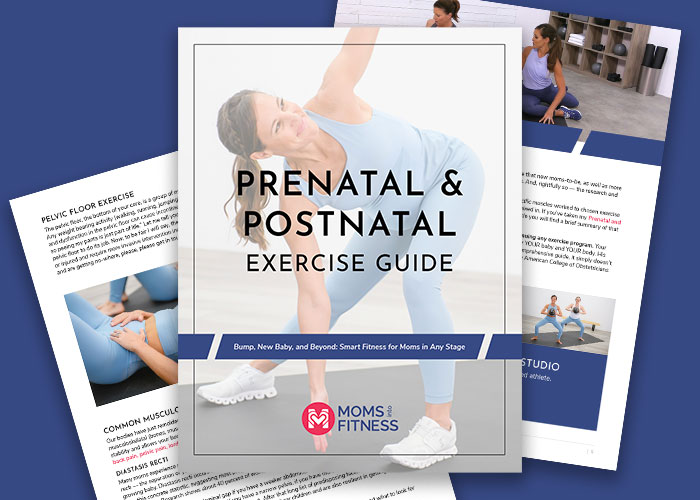
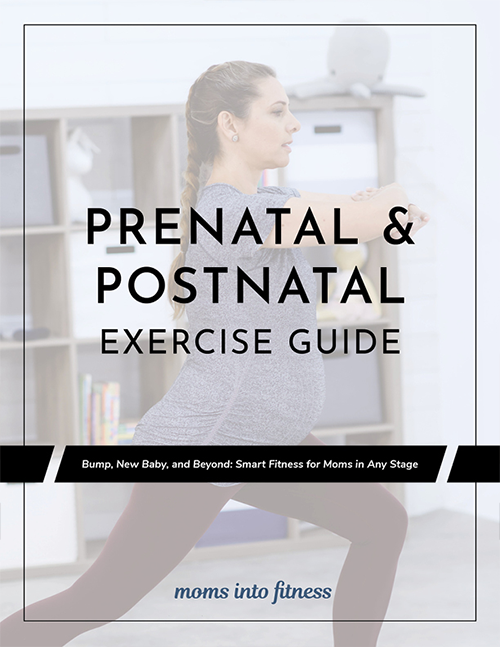
It’s important to manage your expectations about getting your body back. Around 9 – 12 months postpartum you might be back to your pre-pregnancy weight — anything before that is simply unrealistic.
If you’ve had a baby within the last 6 months or are currently breastfeeding, a postnatal-specific workout is so important! The hormones in your body make the tissues more lax, even after the relaxin leaves your system (sometimes several months later). Postnatal workouts will ensure you don’t push yourself into injury.
The Moms Into Fitness Postnatal Program offers two tracks for postpartum moms: beginner and intermediate/advanced and both have two phases. Plus lots of extras to help you feel confident and strong as you transition back into traditional workouts. Try it for FREE!>>
Your body is remarkably adaptable, and your recovery to pre-pregnancy hormone levels, uterus size, and so on is a postpartum miracle. Your core muscles are just as adaptable, but you have to USE all abdominal muscles to make them bounce back. Time, proper core training, and scar mobilization will help in your road to recovery.
Now let’s talk more about the core — it was the most affected muscle group during pregnancy. Your transverse abdominis along with your pelvic floor acted as a sling to your baby for 9 months. This is why you need to train these specific muscles to get back the integrity and strength of your core before returning to traditional abdominal exercises.
If you’re not already, you’re about to become very familiar with a muscle called the transverse abdominis (TA). The TA is a thick layer of muscle that runs from hip to hip, wrapping around the torso from front to back. The muscle fibers of the TA run horizontally, similar to a corset or a weight belt. Strengthening and learning to use these muscles will give you power and tone your entire body, including reducing that C-Section pouch (or whatever other less-than-desirable name you might call it).
These three core exercises are safe for C-section mamas and come from our Postnatal Exercise Program.
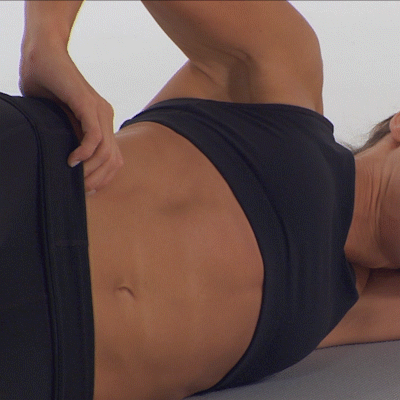
TRANSVERSE ABDOMINIS SIDE BRACING
Setup: Begin lying on your side with your knees bent, feet resting on the floor, and the fingers of your top hand resting on your stomach — just inside your hip bone.
Tighten your abdominals, drawing your belly button in towards your spine. You should feel your muscle contract under your fingers. Hold this position, then relax and repeat. Breathe. Perform for 30 – 60 seconds.
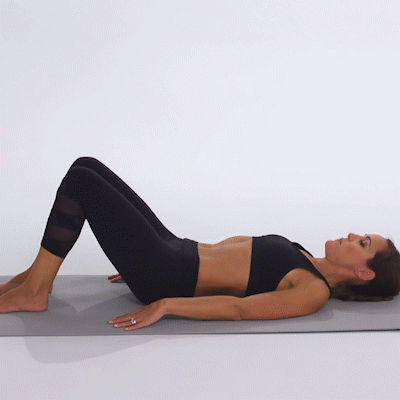
BENT KNEE FALLOUTS
Setup: Lie on your back with your knees bent and feet resting flat on the floor.
Tighten your abdominals. Without letting your hip bones move, slowly lower one knee out towards the floor – only as far as you can without your pelvis moving. Slowly return to starting position. Alternate with other leg, repeat. Brace your core so your pelvis is stationary. Perform for 30 – 60 seconds.
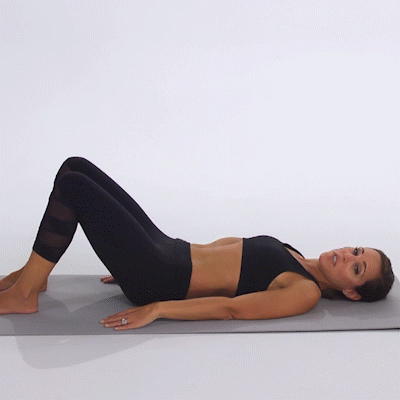
ROLLING BRIDGE
Setup: Begin lying on your back with both legs bent and your feet resting on the ground.
Tighten your abdominals. This will engage your deep core muscles to lift your hips off the ground into a bridge, hold. Lower by rolling down one vertebrae at a time, then repeat. Your body should be in a straight line at the top of the movement. Keep your hips level throughout the exercise. Perform for 30 – 60 seconds.
As much as we want to focus on the core, your body also needs cardio, flexibility/mobility, and full body strength exercises. Moms Into Fitness has postpartum workouts in all your favorite formats:
All of these can be found in our Postnatal Program. Please remember to listen to your body, and ease into exercise with a postnatal workout routine only if it can be done pain free.
A C-section is a surgical procedure, but unlike what most women think, your doctor does not cut through muscle with the exception of the uterus. When a C-section is performed the skin and fascia is cut horizontally, then the abdominal muscles are separated from one another and moved to the side. These muscles are rarely cut, and if they are they are usually put back together. While the muscles are not cut, the procedure greatly interrupts the function of the muscles and their ability to respond to movement.
During a C-section, the transverse cut, or bikini cut, follows the natural curve of the lower stomach, and causes minimal complications. But a C-section can create a distended belly pooch or shelf like area around the scar. More than likely, this will go away with healing, proper core training, and scar mobilization.
You might experience numbness for a few months after birth — nerves were cut! Your resumption of exercise will be slower. In the beginning, it is best to stay away from lying on your belly or any movements that bother your incision site. Only do things you are completely comfortable doing. You can add a support to your abdominal area with a pillow for more comfort.
Some women find comfort in wearing a postpartum support band or belly band. I recommend these should be used for comfort; however, beyond that our body tends to use it as a “crutch” and leans on the “support” instead of recruiting muscles to strengthen the core. No brand of shapewear can tighten a woman’s abdominal muscles — you must rely on nature and a postpartum exercise plan to do that.
Many women are dismayed to discover a shelf, bulge, pouch, or pooch (all terms I’ve heard from women!) that protrudes over their C-section scar. I experienced this phenomenon after my first C-section, and appealed to my Ob/Gyn, Dr. Kent Snowden, for an explanation. He assured me that this “shelf” was probably fatty tissue damage, and that it was so prominent because of swelling. Once the parts of my body, inside and out, had settled back into where they belonged, the scar tissue should remain the only evidence of the surgery.
With patience and scar mobilization (more on that below), the bulge will reduce over time.
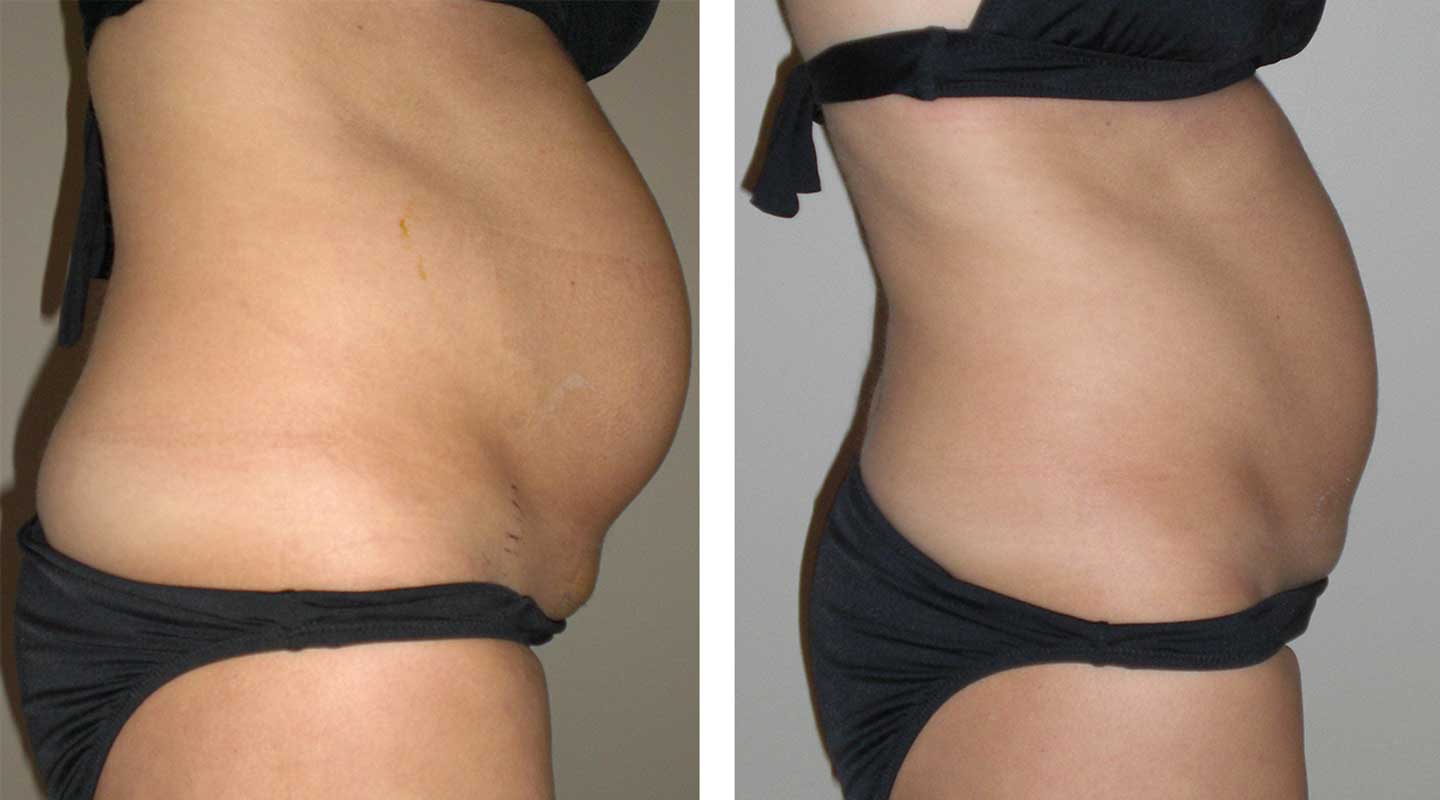
The image on the left above shows my profile post-operation at one week postpartum, before any scar mobilization or exercise. The image on the right shows me at 10 weeks postpartum after scar mobilization and beginning to exercise again.
A woman who has sustained multiple C-sections will end up with more scar tissue. Whether she chose stitches, staples, or tape for suturing should not make a difference in the amount of fatty tissue damage or scar surface area.
Normal tissue in our bodies is aligned in a nice uniform direction. However, when scar tissue forms, it is kind of like your toddler played pick-up sticks and tossed them all over the floor. The tissue is laid down in haphazard directions. Your C-section scar is no different. The scar tissue can stick to the tissues underneath and to the abdominal muscles.
This scar tissue can cause many more problems beyond cosmetic. When the scar tissue impacts the muscles around it, it can cause issues with the deeper core muscles firing correctly, incontinence, back pain, and pain with sexual intercourse.
Women who have struggled with back and pelvic pain for years are doing everything they can think of to improve their symptoms, and are feeling defeated — only to find out their C-section scar is preventing them from being successful. Let’s work those scars and get them conquered early in the game so you can move on to the fun stuff!
So often I find that moms think that once they have a C-section scar, it is what it is and there is not much they can do about it. There is hope mommas!
Scar tissue responds very well to mobilization. I know … big words … sounds fancy but it is quite easy to do on your own.
First, do not get over eager too early in the game — you can pull open your incision. Wait until your incision is fully healed! Then put your fingers down along the incision and move your incision/scar in every different direction. Start gently. All of this should be fairly pain free. After you can do this with gentle pressure, deepen your pressure. A little soreness is ok, but do not torture yourself! Be patient, it is not going back to normal overnight, regardless if your scar is 4 weeks old or 10 years old.
If you have a thick scar that is super tender and angry, or are dealing with issues with back pain, incontinence, or diastasis recti, please find a physical therapist/physiotherapist who specializes in women’s health/pelvic health. They will be able to address your scar and other issues and get you back to being supermom much more quickly than if you just do a simple scar tissue mobilization at home.
Download the Prenatal & Postnatal Exercise Guide to learn more about the why and how of scar rehabilitation as well as common postpartum conditions like diastasis recti, pelvic floor dysfunction, prolapse, incontinence, and back pain.